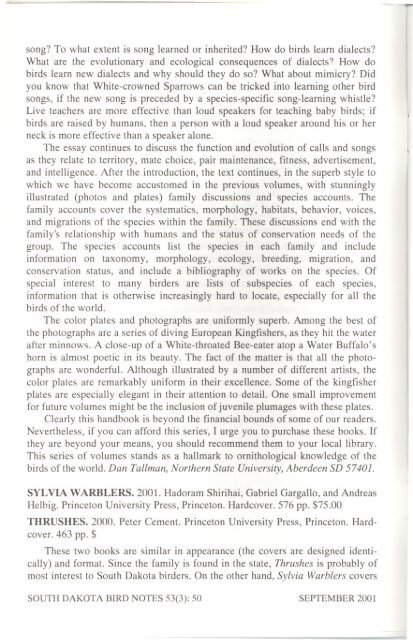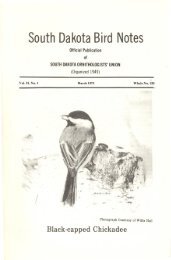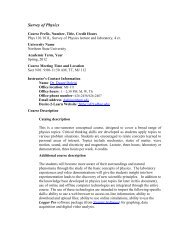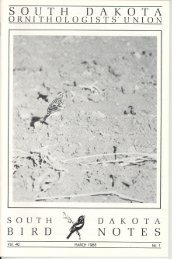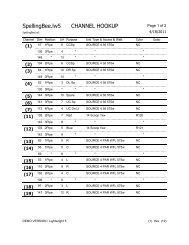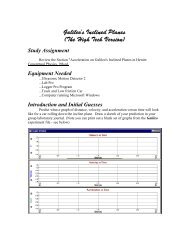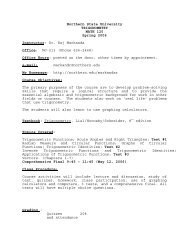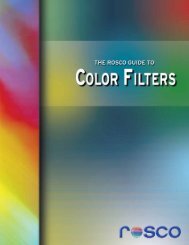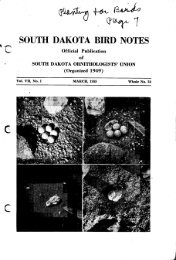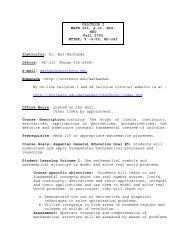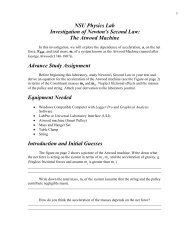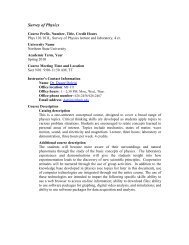...--- -rsong? To what extent is song learned or inherited? How do birds learn dialects?What are the evolutionary and ecological consequences of dialects? How dobirds learn new dialects and why should they do so? What about mimicry? Didyou know that White-crowned Sparrows can be tricked into learning other birdsongs, if the new song is preceded by a species-specific song-learning whistle?Live teachers are more effective than loud speakers for teaching baby birds; ifbirds are raised by humans, then a person with a loud speaker around his or herneck is more effective than a speaker alone.The essay continues to discuss the function and evolution of calls and songsas they relate to territory, mate choice, pair maintenance, fitness, advertisement,and intelligence. After the introduction, the text continues, in the superb style towhich we have become accustomed in the previous volumes, with stunninglyillustrated (photos and plates) family discussions and species accounts. Thefamily accounts cover the systematics, morphology, habitats, behavior, voices,and migrations of the species within the family. These discussions end with thefamily's relationship with humans and the status of conservation needs of thegroup. The species accounts list the species in each family and includeinformation on taxonomy, morphology, ecology, breeding, migration, andconservation status, and include a bibliography of works on the species. Ofspecial interest to many birders are lists of subspecies of each species,information that is otherwise increasingly hard to locate, especially for all thebirds of the world.The color plates and photographs are uniformly superb. Among the best ofthe photographs are a series of diving European Kingfishers, as they hit the waterafter minnows. A close-up of a White-throated Bee-eater atop a Water Buffalo'shorn is almost poetic in its beauty. The fact of the matter is that all the photographsare wonderful. Although illustrated by a number of different artists, thecolor plates are remarkably uniform in their excellence. Some of the kingfisherplates are especially elegant in their attention to detail. One small improvementfor future volumes might be the inclusion of juvenile plumages with these plates.Clearly this handbook is beyond the financial bounds of some of our readers.Nevertheless, if you can afford this series, I urge you to purchase these books. Ifthey are beyond your means, you should recommend them to your local library.This series of volumes stands as a hallmark to ornithological knowledge of thebirdsof theworld.Dan Tallman,<strong>Northern</strong><strong>State</strong><strong>University</strong>,AberdeenSD57401.SYLVIA WARBLERS. <strong>2001</strong>. Hadoram Shirihai, Gabriel Gargallo, and AndreasHelbig. Princeton <strong>University</strong> Press, Princeton. Hardcover. 576 pp. $75.00THRUSHES. 2000. Peter Cement. Princeton <strong>University</strong> Press, Princeton. Hardcover.463 pp. $These two books are similar in appearance (the covers are designed identically)and format. Since the family is found in the state, Thrushes is probably ofmost interest to South Dakota birders. On the other hand, Sylvia Warblers coversSOUTH DAKOTA BIRD NOTES <strong>53</strong>(3): 50 SEPTEMBER <strong>2001</strong>
- --"only one genus of the family Sylviidae. Species in this genus are notoriously difficultto identify and are restricted to the Old World.Thrushes begins with a relatively short introduction, which covers the scopeand organization of the book. It includes sections on taxonomy and behavior,molt and migration. All the genera of the family are reviewed. A few pages aredevoted to behavior and conservation. These 40 pages are sparsely illustratedwith black and white drawings.Sixty color plates follow the introductory remarks. These paintings give anexcellent review of the thrushes, since opposite each plate are small range mapsand short, written descriptions of the birds portrayed. Thus, the reader can easilyreview the world's thrushes, their appearance and distribution. The platesoccasionally show immature birds and various races not often illustrated in fieldguides. For the American Robin, for example, one female and one immature areshown, along with adults of five races. Not all the field marks of these races,however, are demonstrated. None of the examples shows racial variation in robinwhite tail spots, or the spots at all for that matter. Many of the plates have verydark backgrounds, which I think detracts from the birds.Aside from a literature cited section and an index, species accounts comprisethe remainder of the book. Each account covers nomenclature, identification,taxonomy, variation, voice, distribution, habitat, behavior, breeding, molt,measurements, and references. Overall, the book should be a valuable referenceto anyone wishing to learn more about this globally distributed bird family.Sylvia Warblers covers a single genus rather than a family of birds, and,perhaps consequently, devotes much more detail to the birds it covers. Thebook's bulk consists mainly of species accounts. Within each account are colorphotographs and illustrations of each species, showing many plumage andgeographical variations (20 color plates and 546 photographs). Large, full-pagemaps, clearly show the ranges of even the races of the various species. The text isalso illustrated with many black and white drawings, demonstrating behavior andwing formulae. Sonagrams describe vocalizations and many charts comparemeasurements.The accounts include a general introduction to each species, seasonal identificationnotes, and interesting sections on field identification, including similarspecies and "major pitfalls." The accounts continue with voice, identification inthe hand, taxonomy, molt, age and sex. Finally general biology and ecology, includingdiet,behavior, and population trends are covered.No serious birder traveling to Europe or western Asia will want to be withoutthis text. Others may be inspired by its detailed coverage of a single avian genus.Clearlythis book is in a class by itself. Dan Tallman, <strong>Northern</strong> <strong>State</strong> <strong>University</strong>,Aberdeen, SD 57401.SOUTHDAKOTA BIRD NOTES <strong>53</strong>(3): 51 SEPTEMBER <strong>2001</strong>
- Page 1: I .SOUTH DAKOTA IORNITHOLOGISTS'UNI
- Page 4 and 5: fication of Birds of North America
- Page 6 and 7: - - ~1180 individuals banded and 20
- Page 8 and 9: L--: --..Dean, K. L. 1999. Stopover
- Page 10 and 11: I was listening to an unusual sparr
- Page 12 and 13: ..of Black-backed Woodpeckers incre
- Page 14 and 15: .~24 Sep Meade JLB ... Late [l5-Nov
- Page 16 and 17: ..-- --- --Yankton SVS; 02 Aug Robe
- Page 18 and 19: ..American Tree Sparrow Early: 03 O
- Page 20 and 21: PubUshed bySOUl1l DAKOTAORNI1HOLOGI
- Page 22 and 23: SOUTH DAKOTA BIRD NOTES, the offici
- Page 24 and 25: ..ess that is being fought against.
- Page 26 and 27: White-fronted Goose 13% 6Snow Goose
- Page 28 and 29: Hairy Woodpecker 91% 41Black-backed
- Page 31 and 32: - - -Grzybowski, 1. A. 1999. Southe
- Page 33 and 34: en0ẹ..,::r:t:J~0~OJ....:;.:;t:JZ0
- Page 35 and 36: ~A GUIDE TO THE BIRDS OF THE PHILIP
- Page 37 and 38: Brookings KIE; 11 Feb Hughes RDORed
- Page 39 and 40: TJ; 20 Jan Hughes JSP, RFSPurple Fi
- Page 41 and 42: ~!I: ORNITHOLOGISTS'I SOUTH DAKOTAU
- Page 43 and 44: ..~PRESIDENT'S PAGEI had such a bla
- Page 45 and 46: -erably prior to consulting a field
- Page 47 and 48: SUBMITTEDFOR CONSIDERATIONEurasian
- Page 49: '"young cormorants, near flight sta
- Page 53 and 54: ~SEASONAL REPORTSThe 2001 Spring Se
- Page 55 and 56: ----KM; 08 Apr Butte JLBCinnamon Te
- Page 57 and 58: ,-----0Apr Minnehaha RBA; 17 May Be
- Page 59 and 60: Pileated Woodpecker Only Report: 15
- Page 61 and 62: 07 MayUnion RBA ...Late: 12 May McC
- Page 63 and 64: ,I~haha RFS, JSP; 11 May Meade EEMB
- Page 65 and 66: Contributing ObserversRBADBJLBKBAPB
- Page 67 and 68: .~lSD State Lists (31 December 2000
- Page 69 and 70: - ---- JSOU T H D A K 0 r~ORNITHOLO
- Page 71 and 72: ...~PRESIDENT'S PAGEThe September m
- Page 73 and 74: emained at the refuge for 11 days b
- Page 75 and 76: _INelson has cut back sunflower pla
- Page 77 and 78: problems." He explained that Wildli
- Page 79 and 80: within two hours.) Some non-target
- Page 81 and 82: '\of USFWS, Mountain-Prairie Region
- Page 83 and 84: takes three days for the bird to di
- Page 85 and 86: - ,..,rcording to Gamble.NORTH DAKO
- Page 87 and 88: ~IrSMALL RESEARCH GRANTS AVAILABLE
- Page 89 and 90: ';IWhite-faced Ibis reported from H
- Page 91 and 92: Whip-poor-will Reported from Lincol
- Page 93 and 94: Meade, Pennington and Stanley co.Ea
- Page 95 and 96: REPRFSSSNSSVSDRSDSRandy E. PodollRo


